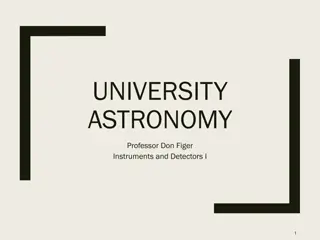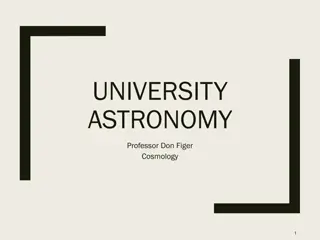
Exploring the Quantum Revolution and Strategic Initiatives in Science
Delve into the next Quantum Revolution and the strategic initiatives shaping the field of Quantum Information Science. Discover the impact of the original Quantum 1.0 Revolution and the advancements paving the way for Quantum 2.0. Explore key documents like the National Quantum Initiative Act and the National Strategic Overview for Quantum Information Science, driving progress in quantum technology. Learn about the importance of a science-first approach and collaboration in Quantum Information Science research.
Download Presentation

Please find below an Image/Link to download the presentation.
The content on the website is provided AS IS for your information and personal use only. It may not be sold, licensed, or shared on other websites without obtaining consent from the author. If you encounter any issues during the download, it is possible that the publisher has removed the file from their server.
You are allowed to download the files provided on this website for personal or commercial use, subject to the condition that they are used lawfully. All files are the property of their respective owners.
The content on the website is provided AS IS for your information and personal use only. It may not be sold, licensed, or shared on other websites without obtaining consent from the author.
E N D
Presentation Transcript
We are LIVE STREAMING! https://connect.rit.edu/pfq
Thank You! PfQ Workshop Organizing Committee Sonia Lopez Alarcon Mike Fanto Don Figer Edwin Hach Gregory Howland Dhireesha Kudithipudi Drew Maywar Parsian Katal Mohseni Seth Hubbard Stefan Preble Mark Tolbert Jing Zhang Ben Zwickl Robyn Rosechandler, Sr. Staff Assistant
program and abstracts are online and in booklet posters are in the corridors talks will be recorded and made available on web site there will be two panels quantum careers quantum integrated silicon photonics lab tours will be on Friday breaks/meals
The Next Quantum Revolution The original Quantum 1.0 Revolution produced an understanding that the world is fundamentally quantum in nature. Led to: transistors and semiconductor microelectronics, LEDs, lasers, CCD-cameras, and magnetic resonance imaging. The Quantum 2.0 Revolution will master the manipulation of the quantum world. Will lead to: quantum computing, imaging, sensing, communication, and clocks.
National Strategic Overview for Quantum Information Science
National Strategic Overview for Quantum Information Science https://www.whitehouse.gov/wp-content/uploads/2018/09/National-Strategic-Overview-for-Quantum-Information- Science.pdf
National Strategic Overview for Quantum Information Science
Choosing a science-first approach to QIS Strengthen Federally-funded core research programs and use approaches ranging from distributed small grants to centers and consortia where appropriate, to support long-term QIS research Foster dialogue and collaboration between quantum- focused researchers across disciplines, and engage the broader scientific community to highlight and share relevant scientific advances, and grow and coordinate the quantum research community Focus on Grand Challenges as a mechanism for driving advancements in the science and technology of QIS, and encourage Federal agencies to identify, prioritize, and coordinate investment in both fundamental and applied challenges
Creating a quantum-smart workforce for tomorrow Use and enhance existing programs to increase the size of the QIS-ready workforce Encourage academia to consider quantum science and engineering as its own discipline, with needs for new faculty, programs, and initiatives at all levels Address education in the area of quantum science at an early stage, including elementary, middle and high school levels Reach out to broader audiences by working with involved agencies and industry to highlight their investments, along with novel or unconventional approaches like utilizing art, media, and engagement with cultural institutions Encourage the QIS community to track and estimate the future workforce needs of quantum industry
Deepening engagement with quantum industry Foster the formation of a U.S. Quantum Consortium with participants from industry, academia, and Government to forecast and establish consensus on needs and roadblocks, coordinate efforts in pre-competitive research, address intellectual property concerns, and streamline technology- transfer mechanisms Increase investment in joint quantum technology research centers by partnerships between industry, academia, and Government to accelerate pre-competitive quantum research and development Maintain awareness of how the quantum revolution may affect agency mission spaces and how agencies can nurture the adoption of quantum technologies within the Federal Government by cultivating potential end-user application spaces
Providing critical infrastructure Identify critically needed infrastructure and encourage necessary investments by working with Government experts and stakeholders, as well as industry and academia. Encourage agencies to provide the QIS research community with increased access to existing and future facilities and supporting technologies Establish end-user testbed facilities along with training and engagement, thereby allowing Federal agencies and stakeholders to explore applications relevant to their respective missions Leverage existing infrastructure, including manufacturing facilities that can be repurposed and expanded, to rapidly advance quantum technology development
Advancing international cooperation Seek to increase international cooperation with like- minded industry and Government partners Ensure the United States continues to attract and retain the best talent, and has access to international technologies, research facilities, and expertise in QIS Identify strengths and focus areas, as well as gaps and opportunities, of international actors to better understand the evolving international QIS landscape from both technical and policy perspectives
RIT Quantum Technology Initiative
The Future Photon Initiative The Future Photon Initiative (FPI) is an RIT signature area funded in response to an internal competition. FPI develops advanced photonics and applies them to solve the most pressing problems in the world. FPI was formed, in part, in recognition of RIT s involvement in AIM Photonics National Network for Manufacturing Innovation (NNMI)
FPI Personnel FPI is led by 20 professors in five colleges and has ~80 personnel in total, including students.
RIT QTI Goals Develop a robust, influential research program in quantum technologies. Leverage RIT s capability/expertise in fabrication and packaging of quantum integrated photonic circuits. Leverage existing RIT/FPI relationships with other researchers, government actors, corporate partners, and facilities to influence overall direction of the field. Develop innovative academic programs to train students to work in the new and expanding quantum industry. Propose a quantum research center.
FPI Grand Challenge Questions Are we alone in the Universe? What do aliens look like? How does the human brain develop? Can we improve outcomes for breast cancer survivors? Can we see in the dark and through obstructions to ensure national security? What is the nature of dark energy and dark matter? Is it possible to build ultra-high speed fully secure global computer networks?
Principals of the FPI Mishkat Bhattacharya Parsian Mohseni Richard DeMartino Raj Murthy Don Figer Zoran Ninkov Ed Hach Rob Pearson Karl Hirschman Stefan Preble Seth Hubbard Roger Remington Bruce Smith Sean Rommel Santosh Kurinec Michael Zemcov Bruce Maeder Jing Zhang Drew Maywar Ben Zwickl
FPI Sub-Units Center for Detectors Integrated Photonics Group NanoPower Research Labs Nanolithography Research Lab Semiconductor & Microsystems Fabrication Laboratory Novel Material Photonics Group Photonic Systems Laboratory Laboratory for Advanced Instrumentation Research Semiconductor Photonics and Electronics Group Photonics and Optics Workforce Education Research Project Simone Center for Innovation and Entrepreneurship Vignelli Center for Design Studies



